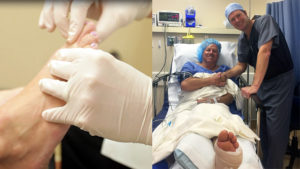How Foot & Ankle Surgery Can Improve Your Quality of Life
On average, the recovery time for foot & ankle surgery can range from 6 to 12 weeks. Recovery time may get longer depending on specific conditions, the type of surgery and an individual’s ability to respond to treatments. Therefore, it is natural to have concerns about the surgical procedure.
While the recovery time may seem daunting, it is essential to focus on the potential benefits that only a surgical procedure can offer. Thanks to the advancements in surgical techniques, foot and ankle surgeries have above 95% success rate with a significantly lesser recovery time.
Due to surgical advancements, the need for traditional open surgeries is reduced. Hence, it can be said that when foot and ankle pain is adversely affecting the quality of life, they should consider the option of surgical procedures. Today’s post provides a discussion on the life-changing benefits of foot and ankle surgery.

What are the life-altering benefits of foot and ankle surgeries?
Mobility plays a vital role in our overall well-being. However, foot and ankle problems impact our ability to move freely and enjoy daily activities. Fortunately, foot and ankle surgery offers a ray of hope for individuals experiencing such difficulties.
Multiple studies have been conducted to investigate the life-altering effects of foot and ankle surgery. Through advanced surgical techniques and personalized care, foot and ankle surgeries can surely improve the quality of life.
Surgery is the best option to regain the freedom of movement
- Directly target the root cause: Foot and ankle surgery specifically addresses chronic pain caused by conditions like arthritis, bunions, heel spurs, or ligament injuries.
- Long-term relief: Surgeries specifically focus on the source of pain, hence long-term relief from chronic pain can be assured.
- Customized approach: Depending on the lifestyle, treatment goals and overall health, a foot doctor can suggest a tailored treatment plan including surgical techniques to help you regain mobility.
- Advanced surgical techniques: Conditions such as ankle instability or tendon disorders can limit movement despite physical therapies or other forms of rehabilitation. Foot and ankle surgery can repair and strengthen these structures through minimally invasive procedures, arthroscopy, and other innovative approaches.
Foot and ankle surgeries are the best for structural issues and deformities
Bunions, hammertoes, flat feet or high arches, all these structural issues affect the alignment of the feet. As a result, foot instability and pain are experienced.
When compared with conservative treatment options, surgeries are considered the best option to alleviate the symptoms associated with these deformities.
Non-surgical treatment for structural issues
- Alignment can be corrected to some extent
- Bracing or orthotics only offer temporary relief
- Physical therapies are inadequate in severe deformities
Surgical treatment for structural issues
- Surgical techniques have the potential for permanent correction
- Surgeries provide a comprehensive solution with realignment, repair and other corrective procedures.
- Surgical interventions are considered safer due to the customized approach and rehabilitation support
Non-surgical treatments can provide temporary relief and may be suitable for mild deformities or functional issues. Foot and ankle surgery offers a more definitive and lasting solution for significant deformities and structural problems.
Modern-day surgical procedure assure improve outcomes and long-term success
Foot surgeons employ advanced surgical techniques that have been refined over time. These techniques minimize tissue damage, promote faster healing, and enhance the overall success of the procedure. These days, surgeries have become minimally invasive which contributes to improved outcomes and long-term success.
- Return to Active Lifestyle: Foot and ankle problems restrict physical activities and hobbies. Surgery can remove these limitations. Individuals can return to sports, exercise, and enjoy a more active and fulfilling life.
- Improved Functional Abilities: Foot and ankle surgeries significantly enhance mobility and strength. From walking and standing to climbing stairs and balancing, surgery can restore stability and strength. This way individuals can perform daily tasks with ease.
- Minimally Invasive Procedures: Many foot and ankle surgeries involve smaller incisions and specialized instruments. As a result, less tissue damage, reduced scarring, and faster recovery times are experienced.
- Enhanced Rehabilitation Protocols: Foot and ankle surgeries are often accompanied by comprehensive rehabilitation programs. These programs include physical therapy, and exercises to optimize recovery.
When does a foot or ankle surgery become essential?
Schedule an appointment with a foot doctor and let them analyze your condition for informed decision making. It is important to seek medical attention when you notice any of the below listed symptoms.
- Chronic pain that persists despite non-surgical treatments
- Bunions or hammertoes, causing pain and functional limitations
- Ankle instability or recurrent sprains
- Inability to bear weight on the affected foot
- Persistent swelling or inflammation
- Traumatic injuries, such as fractures or severe ligament tears
- Nerve compression, causing persistent pain, numbness, or weakness
- Joint stiffness and limited range of motion
- Development of infections or non-healing wounds
- Difficulty in walking or standing
A qualified healthcare professional can evaluate your specific condition, review your symptoms, and conduct diagnostic tests to determine the most appropriate surgical intervention for your condition.

Types of foot and ankle surgery for improved quality of life
Non-surgical treatments are often seen as a more conservative approach to managing foot and ankle pain. Be it cost or recovery time considerations, most individuals assume that non-surgical treatments are more accessible and affordable. However, for improved outcomes and long-term relief, surgical interventions are considered beneficial.
- Total Ankle Replacement
- Bunion removal surgery
- Hammertoe Correction
- Arthroscopic Surgery
- Tendon Repair/Reconstruction
- Ligament Reconstruction
- Flatfoot Reconstruction
It's important to consult with a qualified podiatrist to discuss the potential benefits of surgery in improving quality of life.
Conclusion
Foot and ankle surgery help in restoring mobility and transforming your life. Benefits like efficient targeting of chronic pain, restoring function, and correcting deformities make foot and ankle surgery a preferred option. Individuals who want to regain movement and enhance their overall quality of life can consider advanced techniques, personalized care, and the assurance of long-term success with foot and ankle surgeries.
Consult the board-certified podiatrists at Orange County Foot and Ankle Group to embrace an active and pain-free lifestyle. These highly experienced foot doctors can offer top-notch treatment and enable you to reclaim mobility and improve your quality of life.